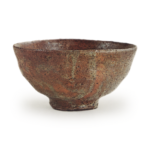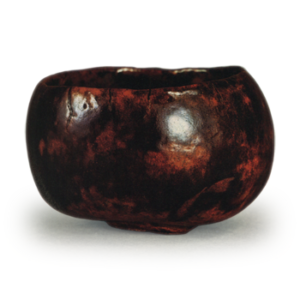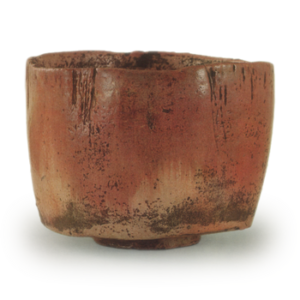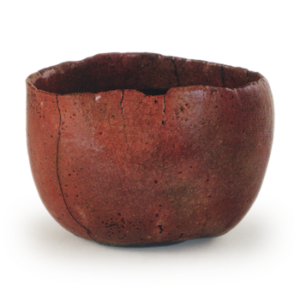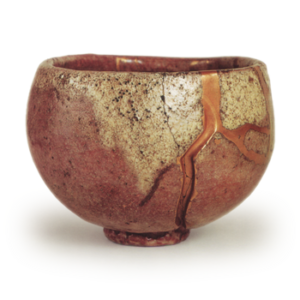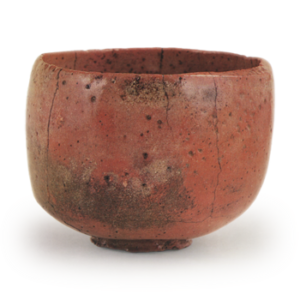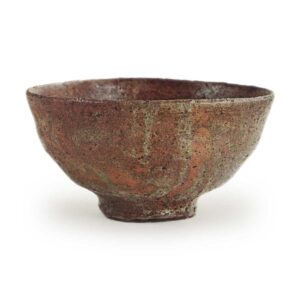
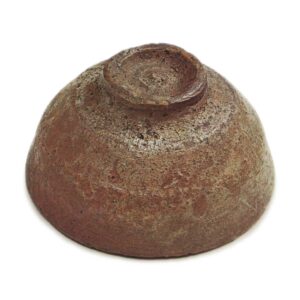
Height: 7.2-7.4cm
Diameter: 13.8-14.2cm
Outer diameter of foot ring: 5.6cm
Height of foot ring: 0.9cm
This tea bowl is unmarked, but it has been kept in the Sekido family, a famous family in Nagoya, for a long time, and this is the first time it has been announced to the public.
Among the many Korean tea bowls, the Kaki obi is considered to be the ultimate in wabi tea bowls, with its deep, austere beauty. The most famous bowls are the Otsu, Kyogoku and Bishamon-do bowls, but even among these austere creations, each has its own distinctive characteristics. The Otsu bowl is full of a warm and elegant atmosphere, while the Bishamon-do bowl is austere and can be said to be on the border between wabi and sabi. There are not many tea bowls that have survived to the present day, but in addition to the three bowls mentioned above, there are also the “Ryūta” bowl, which is listed in the Taishō Meiki Kan, the “Seo” bowl, which was passed down in the Hosokawa family, the “Taki” bowl, which was passed down in the Horita family , and others, including the “Hakua” tea bowl from the Matsudaira family, the tea bowl from the Sakai family, and the tea bowl from the Konoike family.
This tea bowl is similar in shape to the Otsu tea bowl in the collection of the Fujita Museum of Art, and is a graceful work, but it is not as good as the Otsu in terms of the glaze, which is said to be too plain.
The foot of the bowl is carved out in a very tasteful way, and is truly worthy of the name “Kaki no Obi” (Kaki means persimmon, and Obi means belt). The tatami mat is quite thick and has been shaved down to a thin surface, and there are parts where the surface has been taken off. Inside the foot ring, a small spiral pattern can be seen in the center, and the inside of the bowl has been shaved down to a small size. The shaving on the side of the foot ring is quite deep, and so the foot ring, which is like a bamboo joint, is clearly visible. There are two levels of carving, one at the foot and one at the waist, and the bowl rises up and over in a plump, bowl-shaped form, but this style is unique to the Kakinoobi school, and it seems that this tea bowl and the Otsu tea bowl were made by the same person. The body is finely textured with a lathe mark, but it is not very noticeable. The inside of the cup is generally flat, with a slightly deep tea-dama (tea-pool) in the center, and the inside of the cup is wide. From the center to the waist, there are five or six rows of fine, clear, straight lines, but they do not give the impression of being full of power, but rather have a quiet, orderly feel. There are about six marks around the tea-dama, but they are not clear.
The bluish glaze is unevenly applied in thin layers to the purple-red clay body, which contains a lot of iron, but in the thinner areas the reddish clay body is visible, and in the thicker areas the glaze has a lead-tinged grayish blue hue. Small stones contained within the clay are scattered throughout, and the light pinkish-red clay and lead-gray glaze intermingle to create a rich and deep scene with a subdued color sense. The inside glaze is dark reddish brown on one side and light reddish brown on the other, creating a muted color tone. It is completely flawless.
The lid of the paulownia wood box is inscribed in ink with the words “Kakibota teacup”, but according to the accompanying letter when this teacup was passed from the Sekido family to the current owner, it says “Kakinoheta teacup . According to the accompanying letter when this teacup was passed from the Sekido family to the current owner, “This teacup is inscribed with the handwriting of the seventh generation ancestor, and I am pleased to pass it on at your request. Sekido Shigenobu (signature)” is written on the lid, and the Sekido family seal is stamped on the underside of the lid.

